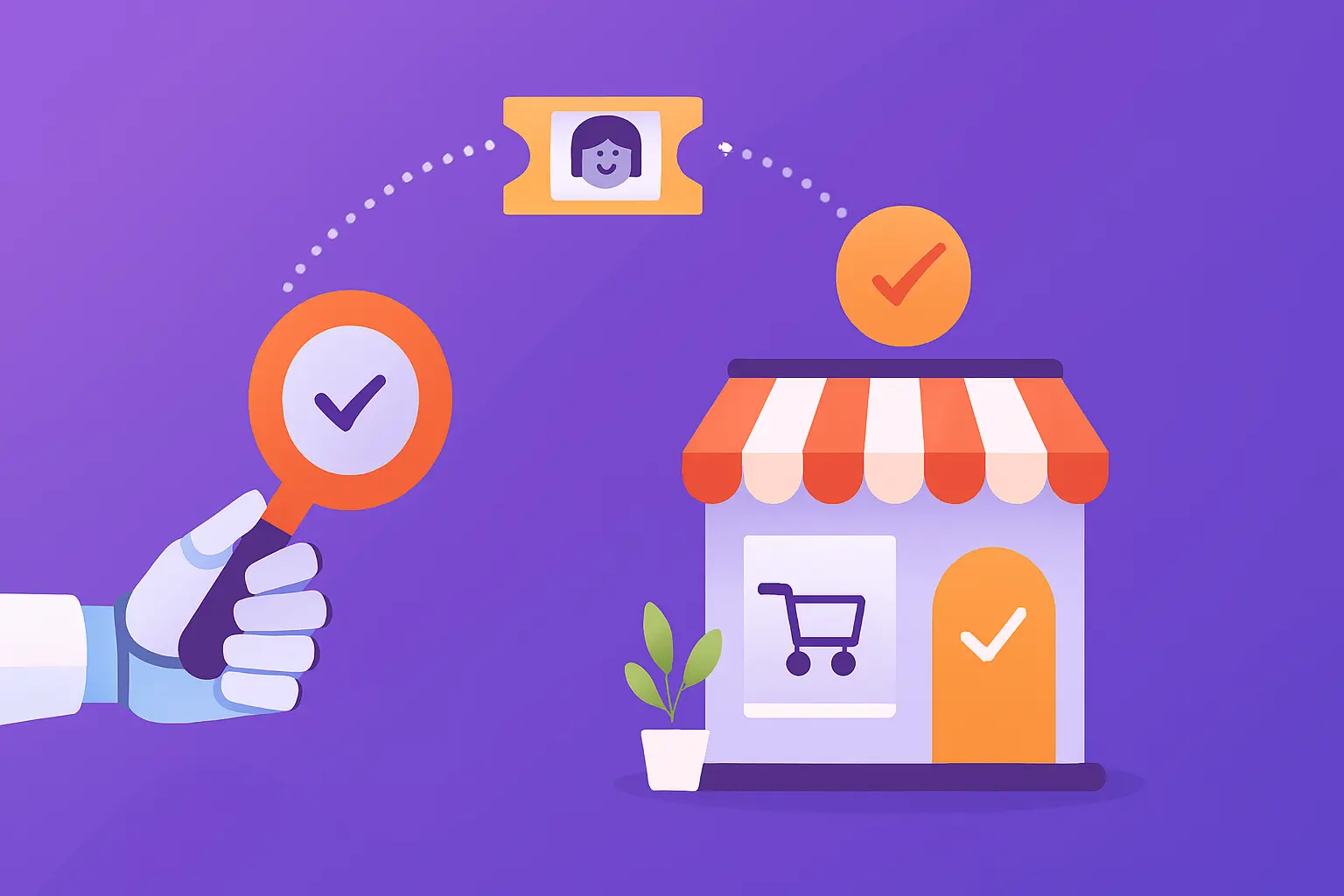What is the Customer Satisfaction Model? Types, Importance & Example
- August 12, 2022
- 19 mins read
- Listen

Businesses that prioritize customer satisfaction tend to outperform their competitors. They are also more profitable in the long run and enjoy improved customer retention rates. Similarly, customers are often more loyal to companies that care about them.
Customers are more likely to make repeat purchases and recommend the business to others when they feel valued by a brand or when their needs are met. All this points to the need for a structured approach to keeping customers happy and satisfied.
This is where the utility of a customer satisfaction model emerges. These models can help you strike a balance between customer expectations and your products or services. Using a well-defined model can help a business identify and address customer pain points systematically.
These models provide a strategic framework to identify and resolve specific issues faced by customers, be it regarding product quality, service delivery, or anything else. They will be key to measuring and improving satisfaction levels.
Plus, A Harvard Business Review study says that 80% of companies use customer satisfaction scores to analyze customer experience and improve it.
In this blog, we will explore the customer satisfaction model in detail, understand its types, importance, and how it can contribute to enhancing customer experience.
What is the Customer Satisfaction Model?
A customer satisfaction model is a structured approach or framework to analyze, measure, and improve customer satisfaction. It’s one of the best tools to measure customer satisfaction levels and take steps to improve that. The model helps businesses measure how happy customers are with a company’s products, services, or overall performance.
The customer satisfaction model is a helpful tool for companies to determine the ways to change, improve, or upgrade their products and services with the view to making customers happy. It takes into account various factors such as perceived quality, perceived value, and customer expectations in establishing customer satisfaction.
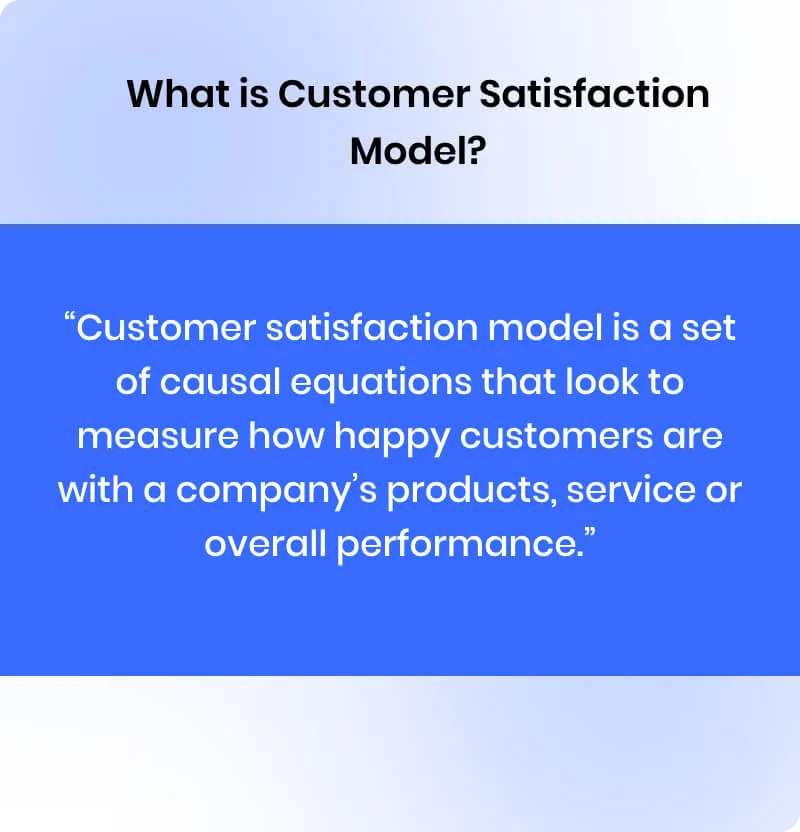
In the online world, e-commerce stores are good examples of how to use this model with perfection and enhance the customer experience with the brand. For instance, when more customers leave purchases mid-way or abandon the cart, it forces e-commerce platforms to analyze the reason behind the problem.
Online stores facing low customer satisfaction rates may first monitor the situation and then understand the reason behind the same. Maybe the slow website speed is driving potential customers away, or maybe the checkout process is complicated, or the navigation is not simple.
There is a proper analysis of user behavior on the site. The company may use surveys or feedback forms to reach the root cause of the problems. Soon, the problems will surface, and then changes will be made.
After that, there will be a constant monitoring of customer satisfaction levels till the desired rates are achieved. This is how a customer satisfaction model helps in creating satisfied customers.
Types of Customer Satisfaction Models
Keeping customers happy and satisfied is always the foremost priority for businesses. To achieve this goal, they can turn to Customer Satisfaction Models, which are available in different types. Each one has a unique approach to measuring and improving customer satisfaction.
The four types of customer satisfaction models are –
- The Disconfirmation of Expectation Model
- The Performance Model
- The Rational Expectations Model
- The Expectations Artefact Model
1. The Disconfirmation of Expectation Model
This model states that customer satisfaction is affected by the combination of the performance of the product and the customer’s level of expectation. As per this model, satisfaction increases when the performance perceived by customers is greater than expectations whereas satisfaction decreases when the perceived performance is lower than expectations.
As per this model –
Satisfaction = performance – expectations
2. The Performance Model
This model states that a customer’s perception of a product or service performance, and their expectations of that performance positively impact customer satisfaction. As per this model, performance is perceived as relative to the price paid for the product or service. So, the greater the perceived value relative to the cost, the more satisfied the customer will be.
3. The Rational Expectations Model
This model suggests that there is always an alignment between the actual performance and the average expectations of agents in a market. This model is not ideal for situations involving complex and frequently purchased services.
4. The Expectations-Artefact Model
This model states that expectations don’t have a positive or negative impact on customer satisfaction. It posits that it’s the performance of a product or service that will shape the expectations of customers.
Importance of Customer Satisfaction Model for Business
Happy and satisfied customers are never an accident. They are the result of a customer-centric approach for a sustained period. A business first has to understand customers and their needs better if it wants to deliver satisfaction to them. This is where having a structured approach to customer satisfaction helps.
Let’s look at the importance of the customer satisfaction model for business –
1. Understanding customers better
You should know that 86% of customers will happily pay more for a great service experience. They will also experience higher levels of satisfaction with the business. This kind of customer happens only when a business takes steps to anticipate and identify their needs. It’s also important to know your customer’s preferences and interests better as only this can improve their expectations. A business can use a model of customer satisfaction to ensure its product or service has all the attributes to meet and exceed customer expectations.
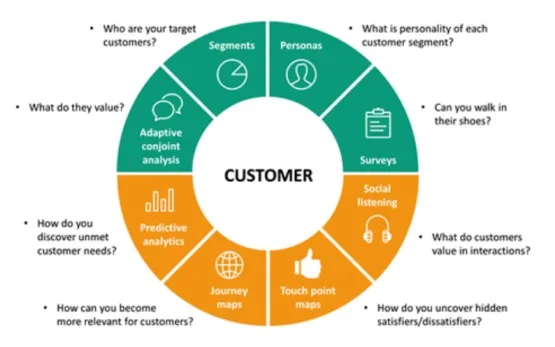
2. Ensuring improved customer engagement
Engaged customers are happy customers. The better you engage them, the more satisfaction they will derive from the association with your brand. Having said that, customers feel more engaged when they have the flexibility to choose their channel of choice in contacting a business. To keep customers more engaged, you should think of adopting an omnichannel communication strategy where you will be where your customers are. All this wouldn’t be possible unless you have a well-defined model for customer satisfaction and follow its practices.
3. Personalizing customer communication
The customer satisfaction model can be a great tool to know the extent of personalization needed to make customers happy. After all, the more you personalize your communication, the more you delight customers. 80% of customers are more likely to buy from a brand that offers personalized experiences. This clearly shows the huge value in making interactions customized to the needs of customers.
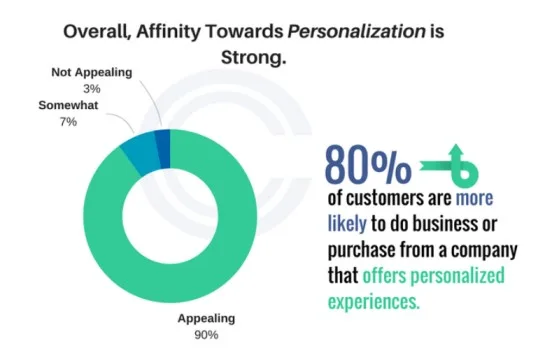
4. Gathering valuable feedback
The customer satisfaction model is invaluable in inspiring businesses to gather customer feedback and ensure improved customer experience. Based on the feedback, it becomes easy to know what customers want and how to make them happy. You can ask for customer feedback after every conversation. You can decide to implement the feedback process at the pre- or post-purchase stage. You can get feedback at every stage of the journey.
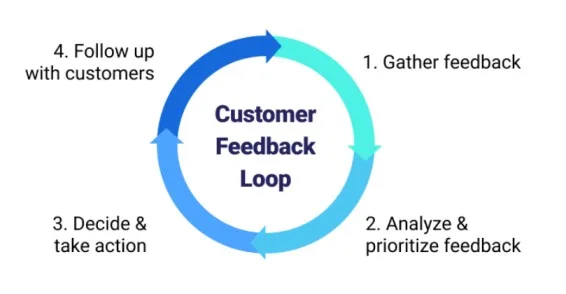
5. Enhancing customer retention
Satisfied customers are more likely to stick with a brand for longer. This can have a positive impact on churn rates. On the other hand, dissatisfied customers may leave earlier and that can hurt churn rates. Using a satisfaction model can help businesses identify issues that cause churn.
Models of Customer Satisfaction Improvement
O’Donnabhain (1998) identified a suitable model for measuring client satisfaction in the construction field. He used Gable’s A Priori Model for data collection and rephrased the assessment dimensions to suit a construction context. He also measured all six of the dimensions of Gable’s Model and then proposed a three-construct recommendation model for increasing client satisfaction.
Let’s look at each of the constructs of the model of customer satisfaction improvement –
1. Monitoring perceptions of client satisfaction
In this construct of the model, the three satisfaction assessment dimensions are retained, and that include, “Consultant Recommendation Satisfaction”, “Consultant Performance Satisfaction,” and “Client Understanding Improvement Satisfaction”. The purpose of retaining these dimensions was because they were found to have the highest influence on the perception of overall client satisfaction.
2. Identifying areas of satisfaction shortfalls
The research into this model found that project managers are ignorant of their clients’ perceptions and are failing to know what and where clients are dissatisfied. This is a major reason why businesses are not able to produce satisfied clients. The solution that was established was to identify areas of satisfaction shortfalls and supplement that with two-way communication.
3. Taking appropriate action
The research into the model showed the value of processing client requirements as the most influential aspect of overall customer satisfaction. The model states the need to adopt a proactive approach to client satisfaction. This could be done by taking appropriate action at the earliest stage and working on the client’s requirements.
As per the model, the three key stages of client need analysis include –
- Requirements identification
- Requirement analysis and prioritization
- Requirement translation
The Kano Model of Customer Satisfaction
The Kano Model is a framework to identify the most important features of a product and their expected role in boosting the level of satisfaction for users. It also shows the relation between customer satisfaction level and the different attributes of a product or service.
The Kano Model was first conceptualized and created by Professor Noriaki Kano in 1984. It was developed as a part of the research into various factors of products or services that satisfy customers.
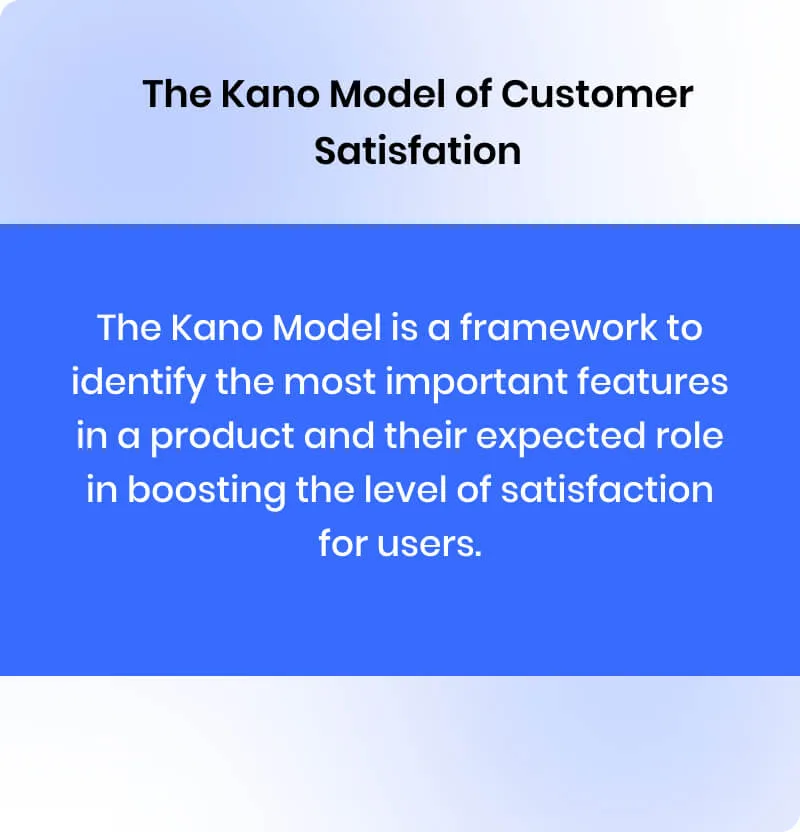
The focus of the Kano model is to help teams view products from the user’s point of view.
By using the Kano Model, it’s possible to create products that not only meet customers’ needs but also ensure lasting value over time.
What are the Kano Model Feature Categories?
In the Kano Model, two categories of initiatives or futures have been identified. Out of the two, product teams need to avoid one set of three while including another set of three feature categories.
The types of features to avoid –
- Indifferent features
- Dissatisfaction features
These features are something product teams should avoid off their roadmap to improving customer satisfaction. Out of the two, “indifferent” features are the ones customers don’t care much about, while dissatisfaction” features are the ones that can upset customers.
The three types of features to include –
- Basic
- Excitement
- Performance
The basic or threshold features must be part of your product. Customers will always expect these features to the extent that they take them for granted. So, product teams must not only include those features but also make sure they function properly. For example, battery life in a smartphone is a basic feature, and customers expect the battery to last them through the day without the need to charge the mobile again and again. If this basic feature does not work properly, customers might feel very frustrated, and that can lead to dissatisfaction.
Excitement features are those features whose absence is not missed much by customers, yet their presence can delight customers beyond imagination. If product teams invest in those features, it will create high levels of customer delight. Innovative and surprising features often fall in this category as they have a huge positive effect on customers and may contribute to enhanced satisfaction levels. Introducing wireless charging in your range of smartphones can work as an “excitement” feature. While customers may not miss it if not available, having it will certainly improve their excitement and satisfaction with the brand.
Performance features are those features that help you increase customer satisfaction. These features drive the performance of your product and they often become a determining factor for customers between choosing yours or competitor’s product. Storage capacity in the smartphone could be an example of the performance feature. Low storage capacity on your mobile might force customers to switch to a competitor’s product.
When and Why Businesses Should Use the Kano Model?
The Kano Model is a helpful framework for prioritizing features in a product with respect to the available time and resources at hand. Product teams can rely on this model when they develop new products and want to be sure of the right mix of features to work on next.
This model is effective for teams looking for guidance to know –
- Which minimum-threshold features they must build
- Which performance features they should invest in
- Which customer-delight features will be liked most by customers
Product teams can use the model when developing any product and seeking inspiration. It can prove very beneficial for teams aiming for quality products yet working to tight deadlines and with limited resources.
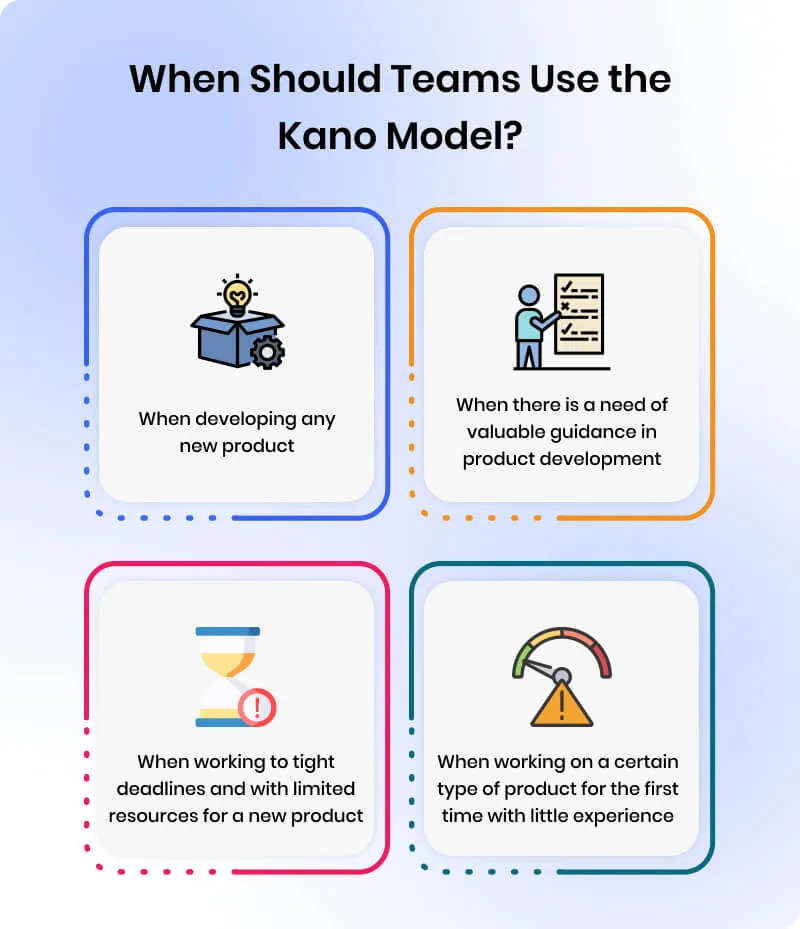
At the same time, the Kano Model is a great help for teams that have little experience or that are working on a certain type of product for the first time. It can be a fantastic resource for teams looking to release a new product to the market as soon as possible.
The real value of the Kano model lies in giving product teams all the answers they need to make their products stand out in the market. The model emphasizes how there are many different features that can be included, but you should consider only those that make customers satisfied and happy with your product.
How Does the Kano Model Work?
The Kano Customer Satisfaction Model brings a rational, structured approach to product development. It also offers a great insight into the product attributes that are supposed to be important to customers.
Teams that employ this model pull together a list of potential new product features or attributes with the capability to enhance customer experience. Those attributes are then weighed according to two key criteria –
- The resources and investment needed to implement them.
- Their potential to make customers happy.
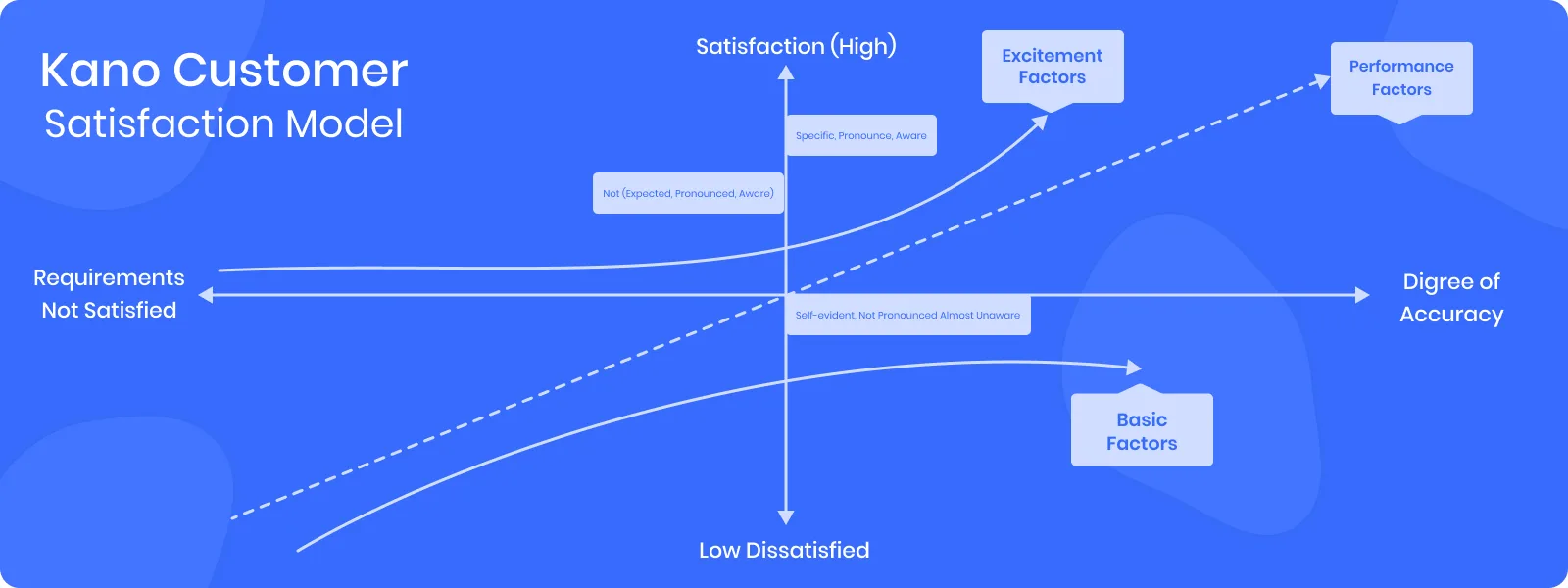
As per the model, the product attributes are split into four categories –
- Threshold Attributes – Customers expect these attributes, and therefore, they are the “musts” of a product or service.
- Performance Attributes – These are features that deliver a proportionate increase in customer satisfaction, and customers are always willing to pay for a product for its performance attributes.
- Excitement Attributes – These attributes are generally unexpected by the customers, and their presence naturally delights them and ensures high satisfaction.
- Indifferent Attributes – They have little or no importance to the customer, and neither do they impact the decision-making.
Customer Satisfaction Model Example
Customer satisfaction models take a strategic approach to identifying customer issues and then working on them to improve happiness levels. These models are important to the industry and can be invaluable tools for enhanced customer satisfaction.
Let’s look at some customer satisfaction model examples –
- American Customer Satisfaction Index (ACSI)
- SERVQUAL Model
- Net Promoter Score (NPS)
- Customer Satisfaction Score (CSAT)
- Customer Effort Score (CES)
Let’s discuss each model example in detail.
1. American Customer Satisfaction Index (ACSI)
The ACSI is a national cross-industry measure of customer satisfaction that represents the U.S. economy. It’s an economic indicator of consumer sentiment based on a nationwide survey. This index uses a survey in which consumers rate the products and services they use. Annually, about half a million consumers are quizzed for the index that rates customer satisfaction. It includes more than 400 companies across 40+ industries.
2. SERVQUAL Model
SERVQUAL is a popular model that is used to measure service quality. The model was developed to look at different parts of service quality and how customers view them. The purpose of creating this model was to help businesses measure and control the quality of their services. This model measures the difference between what customers want and how they feel about the service they receive. Based on that, companies can analyze where their service delivery is lacking and where it could be improved.
3. Net Promoter Score
Net Promoter Score (NPS) is a widely used customer loyalty and satisfaction metric. It measures the level at which customers are more likely to recommend a product or service to someone else. This metric is a key aspect of customer experience and satisfaction improvement efforts of businesses across industry verticals. In this, a single-question survey is used where customers are asked to rate a number ranging from -100 to +100. Based on the responses, three key categories, 1) promoters, 2) passives, and 3) detractors, are established.
4. Customer Satisfaction Score (CSAT)
It’s a popular measurement for customer satisfaction that businesses use to understand how happy or unhappy customers are with their products, services, or support. With CSAT, customers are asked to rate their satisfaction on a liberal scale, and the total score is divided by the number of participants to get the score. Measuring customer satisfaction scores is key to recognizing the pain points of customers and then addressing them in a timely.
5. Customer Effort Score (CES)
CES is a customer experience metric that measures the effort customers take in engaging and interacting with a brand. The real value of this metric lies in measuring the effort customers make to get their issues resolved. Based on the score, a business can take the necessary steps to improve customer satisfaction.
Tips to Boost Customer Satisfaction
Happy and satisfied customers often build the foundation of success for a business. That’s why customer satisfaction should always be a top priority, as it can determine the fate of an enterprise. The good thing is that it does not take a lot to improve customer satisfaction if a business has the intent for the same.
Here are some key tips to boost customer satisfaction –
1. Provide 24×7 customer service
It’s important to engage your customers 24×7 to answer their queries even when your support team is away or busy. You can use AI chatbots to collect basic customer details, such as name, email, etc., for meeting personalization targets. You can combine chatbot with live chat for hybrid support so that customers’ complex queries are handled by humans while routine ones are handled by bots.
2. Deliver faster resolutions
Customers feel happy when their queries or issues get faster responses. So, you should consider using live tools such as video chat and co-browsing to gather key customer information, quickly identify the issue, and ensure faster solutions. Engagement tools can help you diagnose the problem in the first contact issue via chatting and collaborating with the customer browser. Similarly, live tools are great for guiding your customers through various stages and across their entire lifecycles.
3. Consider customer preferences
You can never achieve higher levels of customer satisfaction unless you consider their preferences and needs. That’s why taking a regular survey or collecting regular feedback becomes important. It will help you understand customers and their preferences better. You can also adopt proactive engagement with customers and better understand what they expect from your business.
4. Analyze customer journey across touchpoints
You can analyze customer journeys across touchpoints and gain key insights into their preferences and behavior. This will help you make relevant changes to product design and also to your customer service strategy. Based on the analysis, you can be present across all channels and make it easy and quick for customers to get help.
5. Create a buyer persona
A business needs to do the research and analyze its current customer base to create a buyer’s persona. This step is key to getting detailed knowledge of your ideal customers. After that, it becomes easy to understand what customers may like about your products, what they won’t, and what changes they would like to see in the future.
Use Engagement Tools to Boost Customer Satisfaction
Your business will need the right mindset and quality tools if it wants to achieve happy customers.
We at REVE Chat understand the value of customer satisfaction and strive to offer the best engagement tools for the same.
Your business can use our advanced AI chatbot software to automate customer service, ensure instant replies, and delight customers to no end.
With our co-browsing and video software, you will find it easy to visually engage with your customers and deliver value to them at each stage of the journey.
Similarly, you can combine the chatbot with live chat software and deliver hybrid support where humans will take care of complex conversations while technology will handle everyday simple questions.
Customer Satisfaction Model – Key Takeaways
We have learned how prioritizing customer satisfaction is beneficial for businesses as it leads to more profits and higher rates of retention.
We also discussed the types of customer satisfaction models, including –
- The Disconfirmation of Expectation Model
- The Performance Model
- The Rational Expectations Model
- The Expectations Artefact Model
At the same time, we understood the importance of the customer satisfaction model for business at many levels, including in- –
- Understanding customers better
- Ensuring improved customer engagement
- Personalizing customer communication
- Gathering valuable feedback
- Enhancing customer retention
The blog also touched on the various models of customer satisfaction improvement. A detailed discussion was done on the Kano Model of customer satisfaction and its feature categories.
The focus was also given on when and why businesses should use the Kano Model and how the model works. We also explained the customer satisfaction model example in detail.
In the end, we also touched upon various tips to boost customer satisfaction, including –
- Provide 24×7 customer service
- Deliver faster resolutions
- Consider customer preferences
- Analyze customer journey across touchpoints
- Create a buyer persona
So, you can prioritize customer satisfaction with REVE’s top-class service software. You can sign up now and access a free trial of top customer engagement tools and deliver value at each stage of the journey.
Frequently Asked Questions
Yes, customer satisfaction models are helpful and effective for both B2B and B2C businesses. A business can tailor this model to their specific needs and achieve higher levels of customer satisfaction.
Yes, it’s possible. For that to happen, a small business first needs to collect feedback and then understand customer concerns. It then needs to respond to those concerns that can help enhance satisfaction.
The customer satisfaction model brings a well-defined approach to identifying and addressing customer concerns. This can help enhance overall customer satisfaction and contribute to improved retention rates.
The three key metrics used in customer satisfaction models to measure success are –
1.Net Promoter Score (NPS)
2.Customer Satisfaction Score (CSAT)
3.Customer Effort Score (CES)
The key components of customer satisfaction model include –
1.Identifying customer concerns
2.Gathering feedback
3.Analyzing customer journey touchpoints
4.Establishing benchmarks
5.Ensuring timely responses
6.Focusing on quality service
7.Achieving continuous enhancement




